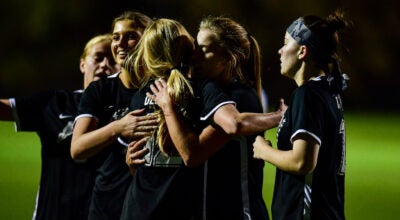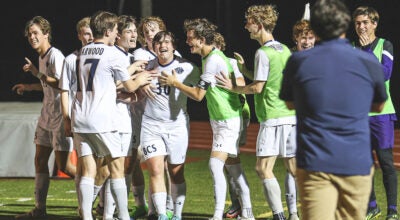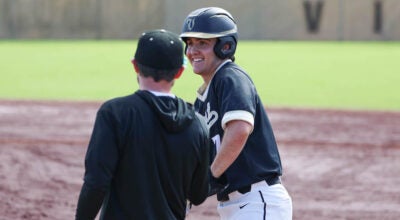AHSAA shares fall sports guidelines in ‘Return to Play’ plan
Published 2:44 pm Thursday, July 23, 2020

- The AHSAA announced its 'Return to Play' plan on Thursday, July 23, which addressed what fall sports will look like in Alabama this year. (File)
|
Getting your Trinity Audio player ready...
|
By ALEC ETHEREDGE | Managing Editor
On Thursday, July 23, the Alabama High School Athletic Association held a press conference to discuss its Return to Play “Best Practices” for the upcoming 2020 fall sports season, after announcing a day earlier that the season would start as scheduled.
With fall practice allowed to start on Monday, July 27, for all sports (helmets and shorts for football and acclimation for other sports), the AHSAA shared its plan to make fall sports as safe as possible over the coming weeks and throughout the season.
“No one is wrong regarding their opinion due to COVID-19. This association respects each and every one of your opinions,” AHSAA Executive Director Steve Savarese said during the press conference. “I want you to also respect ours and the Central Board of Control for providing an opportunity for our students.”
And while this year will look different for each sport, the student-athletes will now get that opportunity with proper guidelines in place.
When it comes to competing, fall practice starts July 27 with the first scrimmages can happen Aug. 7, while the first date for competitions will be on Aug. 20 for all fall sports.
Most importantly, should a player or coach test positive or be exposed to COVID-19, they are to follow the CDC, ADPH and local health department protocols, meaning currently they would have to quarantine for 14 days or until receiving a negative test.
Any player with a confirmed case will be required to complete a minimum five-day acclimation period before returning to a competition.
With that in mind, local school boards and schools can decide if they don’t think it’s safe enough for a school or schools to participate in sports this fall.
Local school systems will also determine fan attendance and who is allowed at games. Host schools will be required to communicate guidelines and equal access must be allowed for the visiting team.
The AHSAA is going to allow those participating in both virtual and on-campus learning the opportunity to play, but school systems can also make the final decision on that.
If a team has to miss a game for any reason this year, it will be counted as a forfeit, but the AHSAA will look at all forfeitures at the end of the season and evaluate them before the playoffs start.
Contingency plans for fall sports championship play have been developed and will be discussed in October. As part of that plan, the AHSAA is asking that volleyball, cross country and swimming play their area games or playoff qualifying games as early as possible in the season.
School systems will also determine the best method of transportation for student-athletes, whether they ride a bus or take their own vehicles. If riding a bus, the AHSAA recommends that all people on the bus wear masks and have assigned seats so contact tracing can occur.
Host schools will be responsible for providing a clean environment when it comes to locker rooms for visiting schools. If possible, the area should be large enough to maintain social distancing.
If the dressing room is not large enough, visiting teams may consider traveling already dressed in uniforms, dressing separately in groups or limiting the number of players allowed to travel to road games.
As for band members, cheerleaders and other performers, the AHSAA is asking local schools to keep them in mind and make them a first priority ahead of fans. They are allowed to attend and perform at games, but ultimately, the local school system has the final say on who can attend.
Those organizations should be separated from game participants as well as fans at all times.
During games, physical distancing should be maintained when possible. Benches should accommodate proper social distancing with team personnel only and pregame interactions with opponent coaches and players should be limited with social distancing.
It will be encouraged for anyone not playing in the game, including athletes, officials, coaches and anyone else on the sideline to wear masks.
See the entire ‘Return to Play’ plan here.
Each individual fall sport will also endure changes this year. Those changes are highlighted below:
Football
- The team box will be will be from the 10-yard line to the opposite 10-yard line for social distancing, while the coaches’ box will remain between the 25 and the 25.
- Charged timeouts will be extended to a maximum of two minutes in length.
- Intermission between periods and after scoring will be extended to a maximum of two minutes.
- Only one captain from each team may be present at the coin toss.
- Cloth face coverings are permissible, but plastic shields covering the entire face are not unless integrated into the face mask and attached to the helmet and clear.
See the full football plan here.
Volleyball
- The pre-match conference should be moved to the center of the court with one coach from each team. There should be no coin toss with the visiting team serving first in set one then alternating. Rosters should be submitted directly to the officials’ table before the 10-minute mark.
- Limit the officials’ table to essential personnel only.
- Maintain social distancing when substituting.
- Cloth face coverings and gloves are permissible.
- Uniforms can be long sleeved with long pants.
See the full volleyball plan here.
Cross country
- Consider using finish corrals and FAT timing for larger meets as easier to distance at finish. With no FAT timing system consider alternative means of finish place and time to address congestion at finish line. Consider using image-based equipment at finish to assist with picking place to avoid congestion.
- Clean and disinfect frequently touched surfaces and exercise equipment.
- Pre and Post Game Ceremony: Establish cross country specific social distancing meet protocols including the elimination of handshakes before and after the match.
- Social distancing of at least 6 feet should be maintained at all times. No hugging, shaking hands, or fist bumps for support/encouragement.
- Cross country meets should consider using staggered, wave or interval starts.
- Cloth face coverings are permitted.
- Bring your own water bottle.
See the full cross country plan here.
Swimming and Diving
- Require athletes to arrive at venue already in competitive attire or provide alternative accommodations for swimmers and divers to change that allows for 6 feet of social distancing.
- Only one person per lane should be permitted at turning end. Provide hand sanitizer and require lap counters to clean hands and wipe down devices.
- Timers must assemble at the finish of each race, at the edge of the pool within the 6-8 feet confines of the lane which they are timing. Timers should wear cloth facial coverings.
- Require all takeoff judging from the sides of the pool. Space relay swimmers apart from one another. Timers and relay takeoff judges should wear cloth facial coverings.
- Establish multiple sessions for warm-up periods to limit number of swimmers per lane. Restrict the number of swimmers in competition area. Limit number of swimmers per lane during warm-up and warm-down periods.
- Limit number of divers during warm-up by creating multiple sessions. During competition, divers may not approach the board until their turn to compete. Hot tubs should not be permitted. Dive order sheets should be posted in multiple areas to reduce number of divers viewing at the same time.
- Keep the teams on opposite sides of the pool and require the home team to compete in lanes 1-3 and visitors to swim in lanes 4-6.
- Athlete clerking areas should be eliminated.
See the full swimming and diving plan here.









